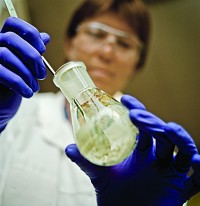Advertisement
Grab your lab coat. Let's get started
Welcome!
Welcome!
Create an account below to get 6 C&EN articles per month, receive newsletters and more - all free.
It seems this is your first time logging in online. Please enter the following information to continue.
As an ACS member you automatically get access to this site. All we need is few more details to create your reading experience.
Not you? Sign in with a different account.
Not you? Sign in with a different account.
ERROR 1
ERROR 1
ERROR 2
ERROR 2
ERROR 2
ERROR 2
ERROR 2
Password and Confirm password must match.
If you have an ACS member number, please enter it here so we can link this account to your membership. (optional)
ERROR 2
ACS values your privacy. By submitting your information, you are gaining access to C&EN and subscribing to our weekly newsletter. We use the information you provide to make your reading experience better, and we will never sell your data to third party members.
Business
Pharma Moves The Old Out And New In
Drug firms shuffle executives and R&D managers and place bets externally to reinvigorate business
by Ann M. Thayer
August 12, 2013
| A version of this story appeared in
Volume 91, Issue 32

“There’s no point in sugarcoating this. This is a quarter where we have disappointed.” Those were the words of Sanofi Chief Executive Officer Christopher A. Viehbacher when he reported the worst first-half 2013 performance among the major pharmaceutical companies. Although Sanofi’s results are still the envy of firms in many industries, the drug company’s first-half earnings plummeted 29.0%, and its sales fell 7.6%.
Last year the pharmaceutical industry fell off a cliff as big-selling products lost patent protection, and the trend is continuing this year: First-half 2013 sales of the top 11 pharma companies dropped 2.2% overall. Combined earnings fell 5.7%. In an attempt to get out of this rut, drug companies have been shifting both operations and personnel.
“I personally don’t like disappointing. My team doesn’t like disappointing,” Viehbacher told stock analysts. He’s frustrated with his company’s mixed financial situation, in which setbacks in animal health and emerging geographic markets counteracted healthy biopharmaceutical and diabetes drug businesses.
“A number of our businesses are doing very strongly and, in particular, I’m very happy about the strong progress we’re making in research and development,” Viehbacher said. “But there’s no question that we’ve hit some speed bumps.” As a result, Sanofi now expects full-year 2013 earnings to be down 7 to 10% from 2012.
Contributing to this decline, for example, the company reported $1.05 billion in 2012 sales of the blood thinner Plavix that it won’t have this year. But Viehbacher anticipates that results in the second half of 2013 will start to look better.
In fact, the second quarter of 2013 will be the last with a significant negative impact from the patent cliff, according to the company. And Viehbacher is happy to be emerging from this phase because it has been a problem for four years. He believes that the “fundamentals of the business are robust.”
Even so, it will take some effort to get back on a positive track, he admitted. Sanofi has been cutting workers and consolidating R&D as part of a cost-reduction plan. “There’s work to be done in getting an organization mobilized through launching new products and growing again,” he said. “Sanofi is a company that hasn’t launched an awful lot of new products in the last 10 years.”
The task is falling to a new team that includes new executives for global operations, strategic commercial development, and animal health. Some of the appointees who have joined from outside Sanofi did so because they see the company as “one that’s willing to do things differently and perhaps take a more radical approach,” Viehbacher argued.
Management changes have become commonplace at pharma firms this year. At Bristol-Myers Squibb, Francis Cuss replaced Elliott Sigal as chief scientific officer on July 1. The change was timed to come after the December 2012 approval of the blood thinner Eliquis, which BMS sells with Pfizer.
However, in the first half of 2013, “we did not get the results we wanted, and we need improvement,” CEO Lamberto Andreotti said about Eliquis and BMS’s U.S. diabetes franchise. And, as Sanofi’s Plavix marketing partner, BMS saw the impact of those lost sales as well.
Overall, BMS had a dismal first half: Sales fell 18.7%, and earnings plummeted 25.8%. Predicting lower sales to continue, the firm has decreased its annual earnings estimate by about 9%. Longer term, the company is betting on growth from its portfolio of immuno-oncology products, such as the rheumatoid arthritis drug Orencia and oncology drug Yervoy.
Challenges at BMS—including the 2012 departure of Jeremy M. Levin, who had led its alliance, partnership, and acquisition strategy and who is now CEO of Teva Pharmaceutical Industries—could result in a “more risk-averse culture,” Citi Research stock analyst Andrew S. Baum warned clients in a recent report. Any such reticence is a negative for BMS, he said, since “the company’s historical success has been linked to its risk appetite both for internal pipeline candidates as well as external deals.”
Meanwhile, Pascal Soriot, a former Roche executive who became AstraZeneca’s CEO in October 2012, has been going full tilt to drive an attempted turnaround. The company has been making numerous deals and acquisitions, while cutting jobs and making other changes to reinvigorate its business.
In January, Soriot fired R&D head Martin Mackay and commercial operations leader Tony Zook. Two months later, he announced plans to change the structure and focus of the company’s R&D organization.
For the first half of 2013, AstraZeneca’s sales dropped 9.9%, and earnings were down 25.7%. Despite the negative impact on revenues from generics competition, Soriot believes the company has made real progress on its strategic priorities. “We continue to invest in distinctive science, our pipeline projects, products, and key markets,” he said on Aug. 1.
In April, Merck & Co. underwent a similar transition when former Amgen executive Roger M. Perlmutter replaced Peter S. Kim as R&D head. In June, Perlmutter eliminated the heads of all of the company’s therapeutic research teams and put in place research managers with functional responsibilities across R&D. The new structure is designed to remove layers in decision making.
While complimenting Merck’s research programs and people during the company’s first-half 2013 conference call, Perlmutter said he still sees “the clear need for changes that will strengthen the return on investment in R&D.” To do so, he intends to make further adjustments in “performance, programs, processes, and people.”
“We’re moving to narrow our focus to make certain that products with unambiguous, clinically meaningful advances receive our complete attention,” Perlmutter said. Recently, the Food & Drug Administration delayed review of Merck’s anesthesia-reversing agent sugammadex and possible approval of its insomnia drug suvorexant.
As at other firms, competition from generics hurt Merck’s financial results, although CEO Kenneth C. Frazier tried to put a good spin on it. “With seven of our top 10 products growing in the second quarter and solid performance overall, we continue to navigate significant patent expiries and adapt to the evolving global health care environment,” he said.
Sales growth for those seven products was not enough to offset the loss in sales for Merck’s asthma drug Singulair. In the first half of 2013, sales of Singulair were $618 million, down from $2.77 billion for the same period in 2012. Overall, Merck’s first-half 2013 sales were down 9.8%, and earnings declined 18.4%.
The picture was similar at Pfizer, where first-half sales dropped 8.7% largely because of the loss of patent protection on the cholesterol drug Lipitor in 2012. Lipitor sales were down by $1.44 billion, or about 55%, compared with 2012. However, new oncology products, such as Inlyta and Xalkori, performed well, along with existing products, such as the analgesics Lyrica and Celebrex.
Pfizer’s earnings picture depended on the view. Excluding special charges and gains, first-half earnings declined 10.0%. But when accounting for gains from the June spin-off of its animal health business as Zoetis, the company reported a net income of $16.8 billion compared with $5.05 billion for the first half of 2012.
Pfizer created Zoetis, and previously sold its nutrition and drug capsule businesses, to focus on its core pharmaceutical operations. At the end of July, it decided to take further steps to reorganize into three business segments by January 2014. One will cover products in multiple therapeutic areas that will have market exclusivity beyond 2015. Another will consist of vaccines, oncology, and consumer health care, and the third will include mature and off-patent products.
This new commercial model “represents the next step in Pfizer’s journey to further revitalize our innovative core, enhance the value of our consumer and off-patent established brands, and maximize the use of our capital,” CEO Ian C. Read said during the company’s half-year earnings call.
Pfizer’s announcement was “consistent with previous management commentary, although a little earlier than expected,” according to Citi’s Baum. But the thinking around the new divisions is not entirely clear. The vaccine, oncology, and consumer products that will be bundled together “seem unlikely bedfellows” and is likely best explained as a move to create balanced revenues, not operational synergies, Baum said. A divestment or spin-off of any of the three businesses is unlikely to happen before 2016, he believes.
AbbVie, the product of just such a split-up, is new to C&EN’s earnings survey. On Jan. 1, Abbott Laboratories split into the drug company AbbVie and a medical devices and diagnostics firm that kept the Abbott name. In the first half, Abbott went on to have modest sales growth and robust earnings growth.
AbbVie saw its sales rise 4.1% and earnings decline 5.3% on a nonadjusted basis. However, more than half of AbbVie’s first-half sales came from just one product, the immunotherapy drug Humira, and it is likely to face competition from generics within a few years.






Join the conversation
Contact the reporter
Submit a Letter to the Editor for publication
Engage with us on Twitter